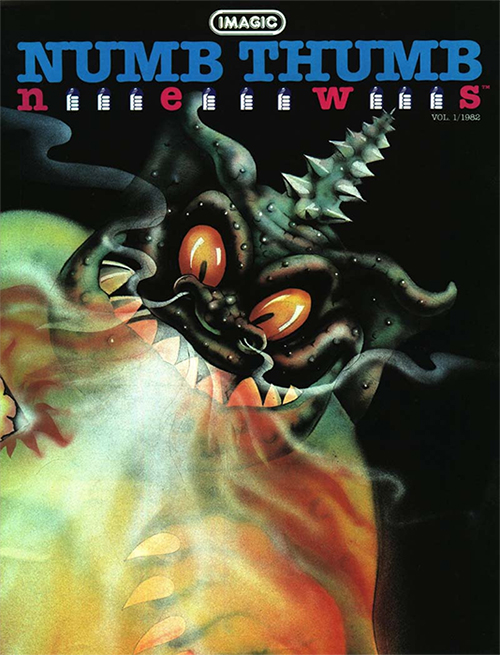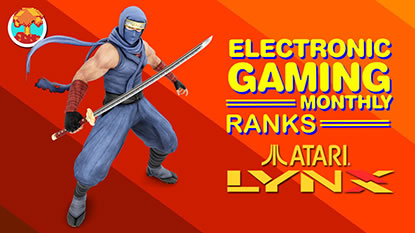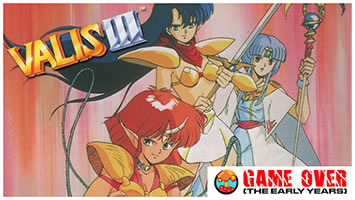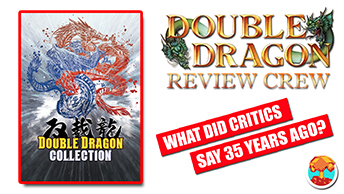- CLASSIC MAGAZINES
- REVIEW CREW
A show recapping what critics thought back
when classic games first came out! - NEXT GENERATION'S BEST & WORST
From the worst 1-star reviews to the best
5-stars can offer, this is Next Generation! - NINTENDO POWER (ARCHIVE)
Experience a variety of shows looking at the
often baffling history of Nintendo Power! - MAGAZINE RETROSPECTIVE
We're looking at the absolutely true history of
some of the most iconic game magazines ever! - SUPER PLAY'S TOP 600
The longest and most ambitious Super NES
countdown on the internet! - THEY SAID WHAT?
Debunking predictions and gossip found
in classic video game magazines! - NEXT GENERATION UNCOVERED
Cyril is back in this spin-off series, featuring the
cover critic review the art of Next Generation! - HARDCORE GAMER MAGAZING (PDF ISSUES)
Download all 36 issues of Hardcore Gamer
Magazine and relive the fun in PDF form!
- REVIEW CREW
- ELECTRONIC GAMING MONTHLY
- ELECTRONIC GAMING MONTHLY RANKS
From Mario to Sonic to Street Fighter, EGM
ranks classic game franchises and consoles! - ELECTRONIC GAMING MONTHLY BEST & WORST
Counting down EGM’s best and worst reviews
going year by year, from 1989 – 2009! - ELECTRONIC GAMING BEST & WORST AWARDS
11-part video series chronicling the ups and
downs of EGM’s Best & Worst Awards!
- ELECTRONIC GAMING MONTHLY RANKS
- GAME HISTORY
- GAME OVER: STORY BREAKDOWNS
Long-running series breaking down game
stories and analyzing their endings! - A BRIEF HISTORY OF GAMING w/ [NAME HERE]
Real history presented in a fun and pithy
format from a variety of game historians! - THE BLACK SHEEP
A series looking back at the black sheep
entries in popular game franchises! - INSTANT EXPERT
Everything you could possibly want to know
about a wide variety of gaming topics! - FREEZE FRAME
When something familiar happens in the games
industry, we're there to take a picture! - I'VE GOT YOUR NUMBER
Learn real video game history through a series
of number-themed episodes, starting at zero! - GREAT MOMENTS IN BAD ACTING
A joyous celebration of some of gaming's
absolute worst voice acting!
- GAME OVER: STORY BREAKDOWNS
- POPULAR SHOWS
- DG NEWS w/ LORNE RISELEY
Newsman Lorne Riseley hosts a regular
series looking at the hottest gaming news! - REVIEW REWIND
Cyril replays a game he reviewed 10+ years
ago to see if he got it right or wrong! - ON-RUNNING FEUDS
Defunct Games' longest-running show, with
editorials, observations and other fun oddities! - DEFUNCT GAMES QUIZ (ARCHIVE)
From online quizzes to game shows, we're
putting your video game knowledge to the test!- QUIZ: ONLINE PASS
Take a weekly quiz to see how well you know
the news and current gaming events! - QUIZ: KNOW THE GAME
One-on-one quiz show where contestants
find out if they actually know classic games! - QUIZ: THE LEADERBOARD
Can you guess the game based on the classic
review? Find out with The Leaderboard!
- QUIZ: ONLINE PASS
- DEFUNCT GAMES VS.
Cyril and the Defunct Games staff isn't afraid
to choose their favorite games and more! - CYRIL READS WORLDS OF POWER
Defunct Games recreates classic game
novelizations through the audio book format!
- DG NEWS w/ LORNE RISELEY
- COMEDY
- GAME EXPECTANCY
How long will your favorite hero live? We crunch
the numbers in this series about dying! - VIDEO GAME ADVICE
Famous game characters answer real personal
advice questions with a humorous slant! - FAKE GAMES: GUERILLA SCRAPBOOK
A long-running series about fake games and
the people who love them (covers included)! - WORST GAME EVER
A contest that attempts to create the worst
video game ever made, complete with covers! - LEVEL 1 STORIES
Literature based on the first stages of some
of your favorite classic video games! - THE COVER CRITIC
One of Defunct Games' earliest shows, Cover
Critic digs up some of the worst box art ever! - COMMERCIAL BREAK
Take a trip through some of the best and
worst video game advertisements of all time! - COMIC BOOK MODS
You've never seen comics like this before.
A curious mix of rewritten video game comics!
- GAME EXPECTANCY
- SERIES ARCHIVE
- NINTENDO SWITCH ONLINE ARCHIVE
A regularly-updated list of every Nintendo
Switch Online release, plus links to review! - PLAYSTATION PLUS CLASSIC ARCHIVE
A comprehensive list of every PlayStation
Plus classic release, including links! - RETRO-BIT PUBLISHING ARCHIVE
A regularly-updated list of every Retro-Bit
game released! - REVIEW MARATHONS w/ ADAM WALLACE
Join critic Adam Wallace as he takes us on a
classic review marathon with different themes!- DEFUNCT GAMES GOLF CLUB
Adam Wallace takes to the links to slice his way
through 72 classic golf game reviews! - 007 IN PIXELS
Adam Wallace takes on the world's greatest spy
as he reviews 15 weeks of James Bond games! - A SALUTE TO VAMPIRES
Adam Wallace is sinking his teeth into a series
covering Castlevania, BloodRayne and more! - CAPCOM'S CURSE
Adam Wallace is celebrating 13 days of Halloween
with a line-up of Capcom's scariest games! - THE FALL OF SUPERMAN
Adam Wallace is a man of steel for playing
some of the absolute worst Superman games! - THE 31 GAMES OF HALLOWEEN
Adam Wallace spends every day of October afraid
as he reviews some of the scariest games ever! - 12 WEEKS OF STAR TREK
Adam Wallace boldly goes where no critic has
gone before in this Star Trek marathon!
- DEFUNCT GAMES GOLF CLUB
- DAYS OF CHRISTMAS (ARCHIVE)
Annual holiday series with themed-episodes
that date all the way back to 2001!- 2015: 30 Ridiculous Retro Rumors
- 2014: 29 Magazines of Christmas
- 2013: 29 Questionable Power-Ups of Christmas
- 2012: 34 Theme Songs of Christmas
- 2011: 32 Game Endings of Christmas
- 2010: 31 Bonus Levels of Christmas
- 2009: 30 Genres of Christmas
- 2008: 29 Controls of Christmas
- 2007: 34 Cliches of Christmas
- 2006: 33 Consoles of Christmas
- 2005: 32 Articles of Christmas
- 2004: 31 Websites of Christmas
- 2003: 29 Issues of Christmas
- 2002: 28 Years of Christmas
- 2001: 33 Days of Christmas
- NINTENDO SWITCH ONLINE ARCHIVE
- REVIEW ARCHIVE
- FULL ARCHIVE
Magazine Retrospective: Numb Thumb News (1982 - 1983)
Long before Nintendo Power and Sega Visions, there was another software maker who had the bright idea to publish their own video game magazine. Their name was Imagic and they were an early 1980s developer who made a name for themselves by releasing simple action games for the Intellivision and Atari 2600. They also published Numb Thumb News, one of the shortest-lived magazines of all time. This is the story of a failed publication that was plagued by lawsuits, a bad business decision and one very big game crash. Today we're going to flip through the pages and explore the history of Numb Thumb News.
Part 1: Introducing Imagic - Before we can talk about Numb Thumb News, we first need to go back to 1981, the year Imagic was founded. Frustrated by the terrible treatment they were receiving at Atari, Bill Grubb, Rob Fulop and a number of other employees left that company and formed Imagic, one of only a handful of third-party developers making games for the Atari 2600 at the time. This led to a string of early 8-bit titles, including Atlantis, Dragonfire and Cosmic Ark. This success also earned the company a meeting with Atari's lawyers, who eventually sued Imagic over the similarities between Demon Attack and the 1980 arcade game Phoenix. The two companies eventually settled out of court and Demon Attack quickly became Imagic's best-selling game.
Not one to sit on their success, the company behind Star Voyager and Microsurgeon created a fan club that could keep the fans in the loop like never before. It was called the Imagic Numb Thumb Club, and it came with a number of exciting perks. Club members would receive a poster of their favorite Imagic game, a personal wallet-sized club card and, most importantly, a one-year subscription to Numb Thumb News, a short-lived magazine filled with tips, tricks, announcements and even interviews. It was basically Nintendo Power six years before Nintendo came up with the idea.
Part 2: It's Not Nintendo Power - Look, I should probably stop comparing Numb Thumb News to Nintendo Power, because that's setting up an unrealistic expectation. Aside from the fact that the two logos are surprisingly similar and both companies created magazines to advertise their games, these two have very little in common. Where Nintendo Power would print lavish maps and reveal all kinds of secrets, Numb Thumb chose to interview the developers and get useful tips like this: "To play an effective game of Star Voyager, it's very important you understand how to steer your spacecraft." Wait ... so you're telling me that knowing how to play the game is the key to doing well? Great strategy, dude.
Where Nintendo Power wanted to be a companion to your gaming experience, Numb Thumb News wanted to sell you on Imagic's latest games. Make no mistake about it, this is an advertisement. The issue will start with a page devoted to previewing games like Demon Attack and Atlantis. This is followed a few pages later with a mail-order section where you can buy games like Demon Attack and Atlantis. And if you $31.95 to throw around, the back of the magazine is devoted to an Imagic contest where you can win some of their hottest games, including, you guessed it, Demon Attack and Atlantis.
Arguably, the most compelling page in Numb Thumb News is this profile on the dean of demon's himself, Rob Fulop. It's here where we learn about the 25-year-old programmer's grueling "four or five hour" work day, where he visualizes the game in his head and makes it a reality. Probably the most surprising thing we learn from this interview is that Rob doesn't play video games. He complains that his reflexes are too slow, and, after being surrounded by 20 monitors all day at work, the last thing he wants to do when he goes home is sit in front of the television. He would rather make games for the hardcore gamers: "That kid is always on my mind when I design a game, daring me to create a game he can't crack. It's a real challenge to try to challenge him." Which brings us to ...
Part 3: Who Was This For? If you read all 26 pages spread across the two issues, you'll start to get a sense of the type of gamer Imagic wanted to attract. This was a company that repeatedly bragged that their games are challenging and only for the roughest and toughest players. All those other games coming from Atari and Activision were for casuals and newbies, while Imagic made real games for the real hardcore market. Each page was practically daring you to be strong enough to play their line-up of titles.
This is understandable, given when the magazine was published. What a lot of Intellivision and Atari 2600 games lacked in depth, they more than made up with challenge. The thinking at the time was that the harder games were the best value, since you would theoretically spend more time mastering them and earning those high scores.
Perhaps that's why the magazine's most visually interesting section was the Numb Thumb Hall of Fame, where players could compare their high scores against the people who actually worked on the games. This is easily the best part of the first issue, as it gives us a look at the style and attitude of those early developers. Sadly, this colorful spread was turned into yet another boring article when issue 2 rolled around. It was nice that readers like Basil Bonner and Troy Whelan got their names published in the Hall of Fame, but I miss seeing the programmers hip '80s fashion. I guess we'll have to settle on these, um, "models" showing off the Imagic merch. Yeah, that's the stuff.
Part 4: What Went Wrong? There are a lot of reasons why Numb Thumbs News didn't stand a chance, starting with the fact that it was only distributed through a fan club, completely bypassing the newsstand. We could also point to that name, Numb Thumbs News, which certainly didn't do it any favors. And then there's the year-long gap between issues and the lack of compelling articles. There's also this guy, Armand Hans III, who looked more like a Bond villain than an editor for a video games magazine. I mean, at one point he explains, with a straight face, that Imagic has "been around for over 1 full year," as if that's a real point of pride.
But while none of those problems necessarily helped, there was something bigger on the horizon that would prove to be the final nail in the coffin. That was, of course, the Great Games Crash, which happened just after Numb Thumbs News published their second (and final) issue. Imagic was not ready to weather the storm that was about to hit, neither as a game maker or a magazine publisher. With the bubble bursting around them and fewer people to sell games to, there was no point in making issue three. And then, only a couple years later, Imagic officially closed their doors for good. Many of the company's biggest games were eventually bought by Activision and the developers moved on to other companies. Rob Fulop, for example, was later hired by Nolan Bushnell to work on Night Trap, followed by him co-founding the company PF Magic, who is probably best known for making the 3D fighting game Ballz.
As for the magazine, Numb Thumb News is little more than a footnote in history these days. It lasted only two issues and barely had anything to offer outside of advertisements for Imagic games. There weren't any good articles, the tips were a joke and the interview actually made the people who worked on the games look worse. It's a great concept that simply came out too early and was gobbled up by the tidal wave that was the Great Games Crash. Numb Thumb News wasn't the first magazine to suffer this fate and, as you'll see in this series, it won't be the last.
Part 1: Introducing Imagic - Before we can talk about Numb Thumb News, we first need to go back to 1981, the year Imagic was founded. Frustrated by the terrible treatment they were receiving at Atari, Bill Grubb, Rob Fulop and a number of other employees left that company and formed Imagic, one of only a handful of third-party developers making games for the Atari 2600 at the time. This led to a string of early 8-bit titles, including Atlantis, Dragonfire and Cosmic Ark. This success also earned the company a meeting with Atari's lawyers, who eventually sued Imagic over the similarities between Demon Attack and the 1980 arcade game Phoenix. The two companies eventually settled out of court and Demon Attack quickly became Imagic's best-selling game.
Not one to sit on their success, the company behind Star Voyager and Microsurgeon created a fan club that could keep the fans in the loop like never before. It was called the Imagic Numb Thumb Club, and it came with a number of exciting perks. Club members would receive a poster of their favorite Imagic game, a personal wallet-sized club card and, most importantly, a one-year subscription to Numb Thumb News, a short-lived magazine filled with tips, tricks, announcements and even interviews. It was basically Nintendo Power six years before Nintendo came up with the idea.
Part 2: It's Not Nintendo Power - Look, I should probably stop comparing Numb Thumb News to Nintendo Power, because that's setting up an unrealistic expectation. Aside from the fact that the two logos are surprisingly similar and both companies created magazines to advertise their games, these two have very little in common. Where Nintendo Power would print lavish maps and reveal all kinds of secrets, Numb Thumb chose to interview the developers and get useful tips like this: "To play an effective game of Star Voyager, it's very important you understand how to steer your spacecraft." Wait ... so you're telling me that knowing how to play the game is the key to doing well? Great strategy, dude.
Where Nintendo Power wanted to be a companion to your gaming experience, Numb Thumb News wanted to sell you on Imagic's latest games. Make no mistake about it, this is an advertisement. The issue will start with a page devoted to previewing games like Demon Attack and Atlantis. This is followed a few pages later with a mail-order section where you can buy games like Demon Attack and Atlantis. And if you $31.95 to throw around, the back of the magazine is devoted to an Imagic contest where you can win some of their hottest games, including, you guessed it, Demon Attack and Atlantis.
Arguably, the most compelling page in Numb Thumb News is this profile on the dean of demon's himself, Rob Fulop. It's here where we learn about the 25-year-old programmer's grueling "four or five hour" work day, where he visualizes the game in his head and makes it a reality. Probably the most surprising thing we learn from this interview is that Rob doesn't play video games. He complains that his reflexes are too slow, and, after being surrounded by 20 monitors all day at work, the last thing he wants to do when he goes home is sit in front of the television. He would rather make games for the hardcore gamers: "That kid is always on my mind when I design a game, daring me to create a game he can't crack. It's a real challenge to try to challenge him." Which brings us to ...
Part 3: Who Was This For? If you read all 26 pages spread across the two issues, you'll start to get a sense of the type of gamer Imagic wanted to attract. This was a company that repeatedly bragged that their games are challenging and only for the roughest and toughest players. All those other games coming from Atari and Activision were for casuals and newbies, while Imagic made real games for the real hardcore market. Each page was practically daring you to be strong enough to play their line-up of titles.
This is understandable, given when the magazine was published. What a lot of Intellivision and Atari 2600 games lacked in depth, they more than made up with challenge. The thinking at the time was that the harder games were the best value, since you would theoretically spend more time mastering them and earning those high scores.
Perhaps that's why the magazine's most visually interesting section was the Numb Thumb Hall of Fame, where players could compare their high scores against the people who actually worked on the games. This is easily the best part of the first issue, as it gives us a look at the style and attitude of those early developers. Sadly, this colorful spread was turned into yet another boring article when issue 2 rolled around. It was nice that readers like Basil Bonner and Troy Whelan got their names published in the Hall of Fame, but I miss seeing the programmers hip '80s fashion. I guess we'll have to settle on these, um, "models" showing off the Imagic merch. Yeah, that's the stuff.
Part 4: What Went Wrong? There are a lot of reasons why Numb Thumbs News didn't stand a chance, starting with the fact that it was only distributed through a fan club, completely bypassing the newsstand. We could also point to that name, Numb Thumbs News, which certainly didn't do it any favors. And then there's the year-long gap between issues and the lack of compelling articles. There's also this guy, Armand Hans III, who looked more like a Bond villain than an editor for a video games magazine. I mean, at one point he explains, with a straight face, that Imagic has "been around for over 1 full year," as if that's a real point of pride.
But while none of those problems necessarily helped, there was something bigger on the horizon that would prove to be the final nail in the coffin. That was, of course, the Great Games Crash, which happened just after Numb Thumbs News published their second (and final) issue. Imagic was not ready to weather the storm that was about to hit, neither as a game maker or a magazine publisher. With the bubble bursting around them and fewer people to sell games to, there was no point in making issue three. And then, only a couple years later, Imagic officially closed their doors for good. Many of the company's biggest games were eventually bought by Activision and the developers moved on to other companies. Rob Fulop, for example, was later hired by Nolan Bushnell to work on Night Trap, followed by him co-founding the company PF Magic, who is probably best known for making the 3D fighting game Ballz.
As for the magazine, Numb Thumb News is little more than a footnote in history these days. It lasted only two issues and barely had anything to offer outside of advertisements for Imagic games. There weren't any good articles, the tips were a joke and the interview actually made the people who worked on the games look worse. It's a great concept that simply came out too early and was gobbled up by the tidal wave that was the Great Games Crash. Numb Thumb News wasn't the first magazine to suffer this fate and, as you'll see in this series, it won't be the last.
HOME |
CONTACT |
NOW HIRING |
WHAT IS DEFUNCT GAMES? |
NINTENDO SWITCH ONLINE |
RETRO-BIT PUBLISHING
Retro-Bit |
Switch Planet |
The Halcyon Show |
Same Name, Different Game |
Dragnix |
Press the Buttons
Game Zone Online | Hardcore Gamer | The Dreamcast Junkyard | Video Game Blogger
Dr Strife | Games For Lunch | Mondo Cool Cast | Boxed Pixels | Sega CD Universe | Gaming Trend
Game Zone Online | Hardcore Gamer | The Dreamcast Junkyard | Video Game Blogger
Dr Strife | Games For Lunch | Mondo Cool Cast | Boxed Pixels | Sega CD Universe | Gaming Trend
Copyright © 2001-2024 Defunct Games
All rights reserved. All trademarks are properties of their respective owners.
All rights reserved. All trademarks are properties of their respective owners.
























